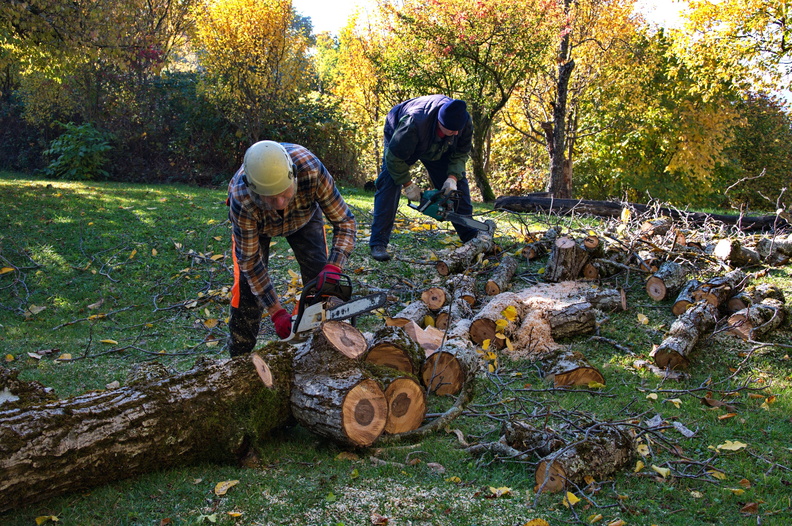Tree Removal: A Homeowner's Guide to Safety and Care
by Eva Braughly Freelance Writer/Blogger
Tree removal is often necessary for various reasons, such as addressing potential hazards, clearing space for construction, or eliminating diseased or dying trees. However, whether you're a homeowner attempting to remove a tree on your own or a professional arborist, it's crucial to prioritize safety, avoid common mistakes, and understand the benefits of tree removal. Additionally, learning about tree care practices can help prevent the need for removal in the first place.
Safety Measures for Homeowners
1. Assess the Situation
Before you embark on a tree removal project, take the time to assess the tree's condition and surroundings. Ask yourself:
Is the tree dead, diseased, or posing a hazard?
Are there power lines, structures, or other obstacles nearby?
Are there strong winds or weather conditions to consider?
If the tree poses a significant risk or the conditions are unfavorable, it's best to consult a professional tree removal service.
2. Wear Safety Gear
Your personal safety should always come first. Equip yourself with the following protective gear:
Helmet
Safety goggles
Gloves
Sturdy clothing
Steel-toed boots
3. Use Proper Tools
Invest in high-quality tools and ensure they are in good working order. Essential tools for tree removal include:
Chainsaw
Ropes
Harnesses
Ladders
It's crucial to understand how to use these tools safely. If you're unfamiliar with their operation, consider seeking professional guidance.
4. Plan Your Escape
Always have an escape route in mind before you make any cuts. Plan a clear path away from the tree's fall zone to ensure your safety in case of unexpected movement.
5. Seek Assistance
If you have any doubts about your ability to safely remove a tree, it's wise to seek the expertise of a professional tree removal service. They have the experience, equipment, and knowledge to handle even the most challenging tree removals safely.
Common Mistakes and Professional Avoidance
Common Mistakes
Many accidents during tree removal occur due to common mistakes. Recognizing and avoiding these errors is crucial:
Improper Limbing: Cutting branches without proper support or in the wrong order can cause uncontrolled falls.
Inadequate Equipment Use: Failing to maintain or correctly use tools can lead to accidents.
Neglecting Safety Gear: Not wearing appropriate protective gear can result in injuries.
Lack of Planning: Insufficient planning can lead to the tree falling in an unintended direction.
Ignoring Local Regulations: Failing to obtain permits or follow local guidelines can result in legal issues.
Professional Avoidance
Professionals can avoid these common mistakes through:
Extensive training and experience
Regular equipment maintenance
Strict adherence to safety protocols
Proper planning and assessment
Benefits of Tree Removal
Tree removal offers several benefits:
Safety: Removing hazardous trees reduces the risk of falling branches or tree collapse during storms.
Property Protection: Eliminating trees near structures prevents damage from root intrusion or falling limbs.
Improved Aesthetics: Removing unsightly or overgrown trees can enhance your property's appearance.
Healthy Growth: Removing diseased trees can prevent the spread of pathogens to nearby trees, promoting overall tree health.
Tree Care for Prevention
Preventive tree care practices can help you avoid the need for removal:
1. Pruning
Regularly prune dead or diseased branches to maintain tree health and shape. Pruning also encourages new growth and improves air circulation within the canopy.
2. Disease Prevention
Monitor trees for signs of disease, such as discolored leaves, cankers, or unusual growths. Promptly address any issues to prevent the spread of disease.
3. Proper Watering
Ensure your trees receive adequate water, especially during dry spells, to prevent stress and dehydration. Proper watering helps maintain tree vitality.
Tree Removal vs. Tree Trimming Services
Understanding the difference between tree removal and tree trimming is crucial:
Tree Removal: This involves cutting down the entire tree, often due to hazards, disease, or other reasons. It's a last resort when no other solutions are viable.
Tree Trimming: Involves selectively cutting branches to shape the tree, improve aesthetics, or enhance its health. Regular trimming promotes healthy growth and can prevent the need for removal.
In conclusion, tree removal is a task that demands careful consideration, whether undertaken by homeowners or professionals. Prioritizing safety, avoiding common mistakes, understanding the benefits, and practicing tree care can help maintain the health and safety of your trees and property. Knowing when to remove a tree and when to opt for tree-trimming services ensures that you make the right choice for your specific situation.
Sponsor Ads
Created on Jan 17th 2024 06:11. Viewed 70 times.



